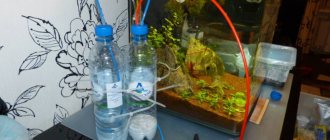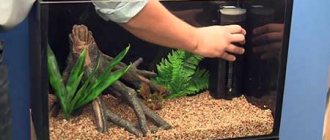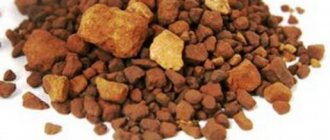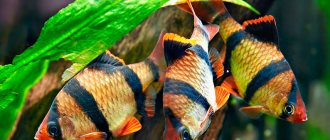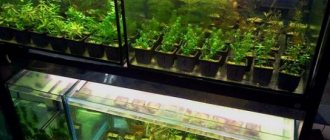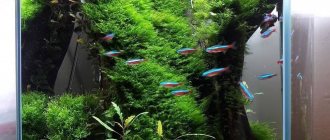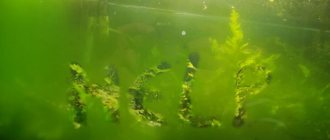Where do phosphates come from?
Phosphate naturally increases as waste decomposes in the aquarium. In addition to being produced internally, phosphates can enter the aquarium from external sources. Everything from fish food to the chemicals used to buffer the water to tap water itself can contain significant amounts of phosphates. Sources of phosphates include:
- Uneaten food
- Plant rotting
- Dying algae
- Fish feces
- Dead fish
- Carbon filter materials
- Aquarium salts
- pH buffers
- kH buffers
- Tap water
Starvation and gluttony: signs of nutritional deficiency in aquarium plants
The speed of plant response to changes in the nutrient medium does not manifest itself in the same way and depends on the type of plant. For example, mosses, rotals, blixa, staurogyne, limnophila and pinnate will feel imbalanced within a few days. Less efficient:
It takes them about a week to realize that something is wrong with their diet. Aroid plants, such as anubias, may notice instability in the nutrient medium only after 15 days.
We will look at the main nutrients and how plants behave when they are deficient.
Desired level
Phosphate is present in both organic and inorganic forms. Test kits can only test for inorganic phosphate, so keep in mind that you are only testing a portion of the total phosphate in your aquarium.
When test results show levels of 1.0 ppm (mg/L) or higher, conditions become favorable for algae growth. At concentrations of 2 to 3 ppm, excessive algae growth may occur. The ideal phosphate level is 0.5 ppm or less.
Redfield ratio for fertilizer application
Redfield Proportion
In this matter, it is better to refer to the table “Redfield Proportion” - the generally accepted ratio of Nitrates (NO3) to Phosphates (PO4), which is calculated as 10 parts NO3 to 1 part PO4. You can withstand 1 NO3 to 0.05 PO4, or 10 NO3 to 1 PO4, etc. Most aquarists adhere to the ratio of 10 NO3 to 1 PO4, because These indicators can simply be kept in a planted aquarium and added as needed. For example, after changing water 2 times a week. But the 10 to 1 parameter is not a panacea; phosphates are also contained in the soil, which is not determined by water tests. Find the ideal ratio for your aquarium through experience. Look at how the plants feel in the aquarium and draw conclusions based on this. The picture below will help you understand what the plant is missing.
But don't forget! When adding fertilizers, someone must absorb them, otherwise you will get algae growth in the aquarium.
Phosphate reduction
The best way to reduce the amount of phosphate in your aquarium is to never allow it to rise in the first place. However, if your phosphate levels are already too high, you can lower them by following these steps.
- Water Changes: Large water changes will help reduce phosphate levels quickly, but the solution will only be temporary if the underlying sources are still present. Continue to do frequent large water changes to monitor phosphate levels until all causes are corrected. However, be sure to test your tap water, as some cities have phosphates in their drinking water. If your tap water contains phosphates, you will need to use filtered or distilled water with added buffer to use for your water change.
- Cleaning the tank: Scrub the inside of the glass. Remove stones and other decorations and scrub them well. Let everything settle a bit, then thoroughly vacuum the gravel base. Wait a few days for things to stabilize, then clean the filter media to remove any trapped algae.
- Phosphate Scavenger: Phosphate Scavenger is very effective. It can be added to almost any filter. Note : Using chemicals should be your last resort.
- Phosphate binder: The fish store has liquid chemicals that can be added to water to cause the phosphate to precipitate out of solution. Use them with caution and start with small doses, as adding too much will turn the aquarium water white and may affect the health of the fish.
Aquarium water tests for PO4 and NO3
How do you know when you need to apply fertilizer? To do this, it is necessary to test the water using aquarium tests for NO3 nitrates and PO4 phosphates. Testing is best done before daylight and after a water change.
After determining the water parameters, it will be necessary to add a certain dose of fertilizer to the parameters that you need.
Maintaining low phosphate levels
Once you've lowered your phosphate levels, make sure they stay low. Here are some ways to avoid spikes in phosphate levels.
- Feed sparingly: The main source of phosphates in an aquarium is flakes. Reduce the frequency and quantity of meals. For most adult fish, a pinch once a day is sufficient. Remove leftover food immediately.
- Change food: Phosphate is used as a preservative in cereal. Not all brands are created equal, so do your research and choose brands that have lower phosphate levels.
- Water Source: Check your water source. Tap water often contains 1 ppm phosphate. If the level is high, look for an alternative source of aquarium water.
- Water Change: Frequent water changes will help phosphate levels keep rising. Change 10 to 15 fifteen percent weekly using a low phosphate water source.
- Tank Maintenance : Keeping your tank clear of debris and algae will help prevent phosphate buildup. Vacuum the bottom frequently to remove food debris, plant debris and fish waste.
- Filter Media: Carbon is a good filter media, but it can add phosphates to the water, so choose carefully. Some carbon media, such as those used in saltwater aquariums, are designed specifically to prevent phosphates from entering the water. Others combine carbon filler with phosphate absorbers so you get the best of both.
- Filter Cleaning: Regularly removing debris from the filter will help reduce sources of phosphate.
- Water Treatment: Buffers that condition water, change or stabilize pH, add trace elements or change hardness often contain phosphate. Don't use them unless they are absolutely necessary. If you must use them, research the product and choose the one that contains the least amount of phosphates.
Self-mixing nitrate and phosphate for aquarium
If you have a desire, then it makes sense to make fertilizers yourself (especially macro). They are simple in composition and do not require particularly precise equipment for manufacturing.
Potassium nitrate (KNO3) is usually used as a nitrogen (nitrate) fertilizer. Its other names are potassium nitrate, potassium nitrate. KNO3 is good because it is both a supplier of nitrates and potassium. In agriculture, sodium nitrate (NaNO3) and ammonium nitrate (NH4NO3) are often suppliers of nitrogen, but they are not suitable for an aquarium, because the first contains sodium, which is not desirable in the aquarium, and the second contains ammonium, which is poisonous to the inhabitants.
Monopotassium phosphate (KH2PO4) or monosubstituted potassium phosphate is used as a phosphate fertilizer. It is also good because it contains only phosphate and the same potassium and nothing extra.
It is best to use these salts purchased in chemical stores of special grade, chemically pure, analytical grade, chemical grade (the first is the purest, but also the most expensive). In large cities there are usually no problems with such stores; in small cities, of course, it is worse (although there is the Internet and you can place an order to a large city, Google chemical laboratories for reagents). If you still have a problem with purchasing reagents, you can use the services of numerous garden and hardware stores. Often these reagents are sold there under the guise of garden fertilizers. BUT! Be sure to pay attention to the composition of the fertilizers you buy. Do not buy various mixtures with an unclear composition or a fertilizer such as “nitrogen fertilizer” that simply contains “saltpeter”. Buy only if it says “potassium nitrate” and there is nothing else in the composition. In addition, “reagents” from garden stores are usually not very well purified and may contain undesirable impurities (well, if they are not poisonous). These impurities may be completely safe for the garden, but not for the aquarium.
It is advisable to prepare fertilizers using purified water. The best option would be distilled water (you can buy it in auto or hardware stores), a good option is osmosis. If for some reason it is not possible to use such water, you can use boiled water. But it is advisable to boil for at least half an hour. This guarantees the destruction of various bacteria and fungi, and also somewhat reduces water hardness.
To prepare nitrate fertilizer, weigh 8 grams of KNO3 (potassium nitrate or potassium nitrate) and dissolve in 100 ml of hot water. For greater accuracy, it is better to dissolve 80 grams of KNO3 in 1 liter of water. If you use potassium nitrate from a garden store, the solution may turn out cloudy due to impurities and will need to be settled and drained from the sediment.
The fertilizer we receive will contain nitrates (NO3) - 50 g/l and potassium (K) - 30 g/l. Accordingly, if we add 1 ml of fertilizer to 10 liters of aquarium water, the nitrate content in the aquarium will rise by 5 mg/l. It should be taken into account that the potassium content will also increase by 3 mg/l.
We make phosphate fertilizer in a similar way. Dissolve 7.5 grams of KH2PO4 (potassium monophosphate) in 1 liter of water. Weighing 7.5 grams on a kitchen scale is no longer so easy, so if you decide to make fertilizer yourself, buy the appropriate scales. Aliexpress a large selection at very reasonable prices. Also, after dissolving the salt, a suspension may appear (in the case of using garden potassium monophosphate), in which case the solution will need to stand.
The phosphate fertilizer we receive will contain 5 g/l of phosphates and 2 g/l of potassium. Accordingly, when adding 1 ml of fertilizer to 10 liters of aquarium water, the concentration of phosphates will increase by 0.5 mg/l and potassium by 0.2 mg/l.
Nutrient deficiency in aquatic plants (description)
Complete list of MACRO and MICRO elements necessary for plant growth:
Nitrogen (N): What affects first: old leaves
| The entire plant turns yellow, with older leaves becoming more yellow than new ones. Old leaves do not die off until nitrogen deficiency becomes critical |
Phosphorus (P) What it affects first: old leaves
| Plants stop growing and become dark green. Some types of plants acquire a purple hue due to coloring plant pigments. If the plant does not have plant pigments, it simply remains green and becomes smaller. The plant sheds its leaves. Signs of phosphorus deficiency are similar to nitrogen deficiency. |
Calcium (Ca) : What affects it first: New leaves (often caused by too much potassium or osmosis)
| Magnesium (Mg) What affects first: old leaves |
Examples of potassium deficiency:
Iron (Fe): What it affects first: new leaves
| Reduction of chlorophyll in new shoots. The leaves and stem react in approximately the same way. The tips of the hornwort turn pinkish and then turn white. The tips of Elodea turn greenish-yellow to yellow, decreasing as the leaf is pressed against the stem. New Echinodorus leaves become smaller, with spots or wide longitudinal stripes that are paler than the rest of the leaf (in mild deficiency). In more severe cases, in most plants, chlorophyll in new shoots disappears completely, which soon dies. The leaves are turning yellow. Greenish veins in the middle of the yellow leaf tissue. It primarily manifests itself in fast-growing plants. |
Examples of iron deficiency:
Sulfur (S): What is primarily affected: new leaves As in nitrogen deficiency
Manganese (Mn): Dead yellowish tissue between the veins of a leaf.
Copper (Cu): Dead leaf tips and withered edges.
Zinc (Zn): What it affects first: older leaves Yellowish area between the veins, starting at the tips and edges of the leaf
Boron (B): What is primarily affected: New leaves Very similar to calcium deficiency. New shoots become twisted and smaller, and then the growing tips of both roots and shoots die. When Cryptocoryne is mildly deficient, the leaves are folded and the roots become shorter and twisted. The tips of the shoots die, and the new edges of the shoots also die.
Molybdenum (Mo): Affected First: Older leaves Yellow spots between leaf veins, then brownish areas along the edges. delayed flowering
Modified 11/2/17 by Button
